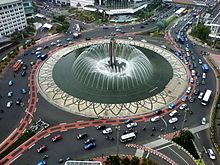
Back Verkeersirkel Afrikaans دوار مروري Arabic Кръгово движение Bulgarian Intersecció giratòria Catalan Kruhový objezd Czech Cylchfan Welsh Rundkørsel Danish Kreisverkehr German Trafikocirklo Esperanto Rotonda Spanish


A roundabout, a rotary and a traffic circle are all, with certain distinctions between them, a type of circular intersection or junction in which road traffic is permitted to flow in one direction around a central island, and priority is typically given to traffic already in the junction.[1][2]
Engineers use the term modern roundabout to refer to junctions installed after 1960 that incorporate various design rules to increase safety.[3][2] Compared to stop signs, traffic signals, and earlier forms of roundabouts, modern roundabouts reduce the likelihood and severity of collisions greatly by reducing traffic speeds and minimizing T-bone and head-on collisions.[4] Variations on the basic concept include integration with tram or train lines, two-way flow, higher speeds and many others.
For pedestrians, traffic exiting the roundabout comes from one direction, instead of three, simplifying the pedestrian's visual environment. Traffic moves slowly enough to allow visual engagement with pedestrians, encouraging deference towards them. Other benefits include reduced driver confusion associated with perpendicular junctions and reduced queuing associated with traffic lights. They allow U-turns within the normal flow of traffic, which often are not possible at other forms of junction. Moreover, since vehicles that run on gasoline typically spend less time idling at roundabouts than at signalled intersections, using a roundabout potentially leads to less pollution.[5][6] When entering vehicles only need to give way, they do not always perform a full stop; as a result, by keeping a part of their momentum, the engine will require less work to regain the initial speed, resulting in lower emissions. Research has also shown that slow-moving traffic in roundabouts makes less noise than traffic that must stop and start, speed up and brake.[7]
Modern roundabouts were first standardised in the UK in 1966 and were found to be a significant improvement over previous traffic circles and rotaries. Since then, modern roundabouts have become commonplace throughout the world,[2]: 2 including Australia, the United Kingdom and France.[6]
- ^ The New Shorter Oxford English Dictionary, Volume 2, Clarendon Press, Oxford (1993), page 2632
- ^ a b c U.S. Department of Transportation 2013, para 1.5.
- ^ Cite error: The named reference
Ourston1995was invoked but never defined (see the help page). - ^ "Roundabout Benefits". Washington State Department of Transportation. Retrieved 12 July 2014.
- ^ Hesch, Maxine. "Quantitatively Determining the Emissions Reduction Benefits of the Replacement of a Signalized Intersection by a Roundabout" (PDF). New York State Department of Transportation. Retrieved 6 October 2013.
- ^ a b "Roundabouts". IIHS-HLDI crash testing and highway safety.
- ^ "Roundabout Rules of the Road". Archived from the original on 9 January 2014. Retrieved 12 January 2014.

